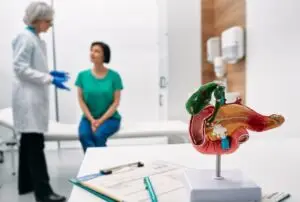Pancreatic cancer is a highly aggressive and often asymptomatic disease, making early detection challenging. The five-year survival rate for pancreatic cancer is dismally low, mainly because the majority of cases are diagnosed at advanced stages when treatment options are limited. However, with advancements in medical technology and research, pancreatic cancer screening has emerged as a potential tool for early detection and improved outcomes. In this blog post, we will explore who should consider pancreatic cancer screening and the importance of early detection.
- Pancreatic Cancer: Risk Factors and Symptoms
Understanding the risk factors associated with pancreatic cancer is crucial in identifying individuals who might benefit from screening. Age is a significant risk factor, with the overwhelming majority of cases occurring in individuals over the age of 45. Some controllable risk factors may also increase your chance of a pancreatic cancer diagnosis including smoking and obesity. Other risk factors include chronic pancreatitis and a family history of pancreatic cancer. Recognizing the early symptoms of pancreatic cancer, such as abdominal pain, unexplained weight loss, and jaundice, can prompt individuals to seek early screening.
- Current Screening Guidelines for Pancreatic Cancer
Several organizations have established screening guidelines for pancreatic cancer. These guidelines typically recommend screening for individuals who are at high risk of developing pancreatic cancer. Individuals with a family history, genetic mutations and chronic pancreatitis are often advised to get screening tests. Many people are not part of an ongoing screening program even though they may be at higher risk than the general population. The current screening methods are limited and research is ongoing to develop more accurate and accessible techniques.
- High-Risk Groups: Who Should Consider Pancreatic Cancer Screening?
Individuals with a strong familial history of pancreatic cancer should be considered for screening if two or more first-degree relatives have been affected. Additionally, those with hereditary conditions like BRCA1, BRCA2, or Lynch syndrome may also be at an elevated risk and should be evaluated for early screening. Moreover, individuals who have undergone treatment for chronic pancreatitis or diabetes are potential candidates for screening due to the increased risk of developing pancreatic cancer associated with these conditions.
- Available Screening Techniques for Pancreatic Cancer
Various screening methods are employed to detect pancreatic cancer at an early stage. Imaging tests, including computed tomography (CT) scans, magnetic resonance imaging (MRI), and endoscopic ultrasound (EUS), are commonly used to visualize the pancreas and surrounding tissues for any abnormalities. Additionally, biomarker tests, such as measuring levels of CA19-9 and CEA in the blood, can provide valuable information in conjunction with imaging tests. Genetic testing is also essential in identifying hereditary pancreatic cancer risk, enabling personalized screening recommendations.
- Benefits and Limitations of Pancreatic Cancer Screening
Early detection through screening offers several potential benefits, such as increased treatment options and improved survival rates. Identifying pancreatic cancer at an early stage allows for more effective surgical interventions, targeted therapies, and a better chance of achieving a cure. Moreover, early detection can lead to better palliative care and improved quality of life for patients.
However, pancreatic cancer screening also has limitations, including false-positive results that may cause anxiety and unnecessary follow-up procedures. Additionally, the sensitivity and specificity of current screening methods need improvement to ensure accurate and reliable results. As a result, screening should be approached with caution, and decisions should be made in consultation with healthcare professionals.
- The Role of Genetic Counseling and Testing
Genetic counseling plays a vital role in guiding individuals at high risk of pancreatic cancer to make informed decisions about screening. A genetic counselor can assess an individual’s family history and recommend appropriate genetic testing to identify any hereditary factors. Understanding the genetic basis of pancreatic cancer risk empowers individuals to take proactive steps towards early detection and risk reduction.
Genetic testing can provide essential information about an individual’s predisposition to pancreatic cancer, helping to tailor personalized screening plans and preventive measures. For individuals with identified genetic mutations linked to pancreatic cancer, increased surveillance and close monitoring may be recommended.
- Early Detection and Beyond: Importance of Lifestyle and Risk Reduction
While screening is a valuable tool, it is essential to emphasize the role of lifestyle modifications in reducing pancreatic cancer risk. Adopting a healthy lifestyle can help reduce the risk of pancreatic cancer, including maintaining a healthy weight through diet and 30 minutes of exercise per day
About 20-35% of pancreatic cancers are caused by cigarette smoking. Quitting smoking is one of the most effective ways to reduce the risk of developing this deadly disease. Additionally, minimizing exposure to environmental carcinogens and managing chronic conditions, such as diabetes and pancreatitis, can contribute to risk reduction.

Pancreatic cancer remains a formidable challenge in the medical field, but early detection through screening offers hope for improved outcomes. High-risk individuals, such as those with a family history of pancreatic cancer or specific genetic mutations, should consider screening options in consultation with healthcare professionals. While screening is an essential step, promoting a healthy lifestyle and risk reduction strategies is equally crucial in the fight against pancreatic cancer. With ongoing research and advancements in medical technology, the future of pancreatic cancer screening holds promise for earlier detection and increased survival rates. By raising awareness about the importance of early detection and empowering individuals with knowledge about their risk, we can take significant steps towards reducing the burden of pancreatic cancer on individuals and communities.
Join the battle
Let’s stand together against pancreatic cancer and strive for increasing the 5-year survival rate to 50% within the next 10 years. We see big opportunities for making advances to pancreatic cancer survival rates.
Establishing a first-of-its-kind program for early detection and prevention includes a research initiative to identify biomarkers of abnormal pancreatic cells so we can intervene before they become invasive cancer cells. We’re also focusing on people who have had multiple family members with pancreatic cancer or who have mutations linked to pancreatic cancer.
The goal is to develop new treatment paradigms to markedly delay or prevent the formation of pancreatic cancer in high-risk individuals. TrovaNOW proceeds go towards collaborative research on pancreatic cancers earlier detection, saving thousands of lives from the world’s deadliest cancer.
If you have any questions or If you want more information about how to donate, just email us at trovanow@gmail.com or learn more by visiting our website www.precedefoundation.org





